Experimental Investigation of Phase Equilibria in the Ti-Cr-V System at 1000–1200 °C
Abstract
1. Introduction
2. Literature Review
3. Materials and Methods
4. Results
5. Discussion
6. Conclusions
- The isothermal sections of the Ti-Cr-V system were determined at 1000, 1100, and 1200 °C. The ambiguous phase regions at 1000 and 1200 °C in the previous studies were discussed and clarified, and the isothermal section at 1100 °C was constructed for the first time.
- The ternary extensions of Cr2Ti were fully elucidated in the present work. As the temperature decreases from 1200 to 1000 °C, the V solubility range of Cr2Ti increases from 5.3 wt.% to 10.0 wt.%, while the Ti solubility range essentially remains constant at approximately 31.0–33.9 wt.%.
- The formulation for the ternary Laves phases was modified to (Cr, V)2(Ti, V), while V primarily replaces Cr. The stability of both Cr2Ti and (Cr, V)2(Ti, V) requires a deficiency of Cr atoms.
- The stable structure of Cr2Ti was C36 at 1200 °C and C15 at 1000 and 1100 °C. It suggests that temperature is the primary determinant of the Cr2Ti crystal structure change from C36 to C15. In contrast, the solid solubility of elements V, Ti, and Cr does not appear to have a notable effect on the stable structure type of Cr2Ti.
Author Contributions
Funding
Data Availability Statement
Acknowledgments
Conflicts of Interest
References
- Bouzidi, A.; Laversenne, L.; Nassif, V.; Elkaim, E.; Zlotea, C. Hydrogen Storage Properties of a New Ti-V-Cr-Zr-Nb High Entropy Alloy. Hydrogen 2022, 3, 270–284. [Google Scholar] [CrossRef]
- Kumar, A.; Yadav, T.P.; Mukhopadhyay, N.K. Notable Hydrogen Storage in Ti–Zr–V–Cr–Ni High Entropy Alloy. Int. J. Hydrogen Energy 2022, 47, 22893–22900. [Google Scholar] [CrossRef]
- Liu, J.; Xu, J.; Sleiman, S.; Chen, X.; Zhu, S.; Cheng, H.; Huot, J. Microstructure and Hydrogen Storage Properties of Ti–V–Cr Based BCC-Type High Entropy Alloys. Int. J. Hydrogen Energy 2021, 46, 28709–28718. [Google Scholar] [CrossRef]
- Liu, J.; Xu, J.; Sleiman, S.; Ravalison, F.; Zhu, W.; Liu, H.; Cheng, H.; Huot, J. Hydrogen Storage Properties of V0.3Ti0.3Cr0.25Mn0.1Nb0.05 High Entropy Alloy. Int. J. Hydrogen Energy 2022, 47, 25724–25732. [Google Scholar] [CrossRef]
- Tukac, O.U.; Ozalp, A.; Aydogan, E. Development and Thermal Stability of Cr10Mo25Ta25Ti15V25 Refractory High Entropy Alloys. J. Alloys Compd. 2023, 930, 167386. [Google Scholar] [CrossRef]
- Liu, J.; Scales, R.J.; Li, B.-S.; Goode, M.; Young, B.A.; Hu, J.; Wilkinson, A.J.; Armstrong, D.E.J. Controlling Microstructure and Mechanical Properties of Ti-V-Cr-Nb-Ta Refractory High Entropy Alloys through Heat Treatments. J. Alloys Compd. 2023, 932, 167651. [Google Scholar] [CrossRef]
- Li, Y.G.; Loretto, M.H.; Rugg, D.; Voice, W. Effect of Heat Treatment and Exposure on Microstructure and Mechanical Properties of Ti–25V–15Cr–2Al–0.2C (wt%). Acta Mater. 2001, 49, 3011–3017. [Google Scholar] [CrossRef]
- Cao, J.; Huang, X.; Mi, G.; Sha, A.; Wang, B. Research Progress on Application Technique of Ti-V-Cr Burn Resistant Titanium Alloys. J. Aeronaut. Mater. 2014, 34, 92–97. [Google Scholar] [CrossRef]
- Huang, Q.; Liu, F.; Huang, C.; Lin, X.; Xia, C.; Wang, Z.; You, Q.; Liu, L. Achieving Superior Burn Resistant and Mechanical Properties of Ti40 Alloy by Laser Solid Forming. J. Manuf. Process. 2023, 102, 406–415. [Google Scholar] [CrossRef]
- Shao, L.; Li, W.; Li, D.; Xie, G.; Zhang, C.; Zhang, C.; Huang, J. A Review on Combustion Behavior and Mechanism of Ti Alloys for Advanced Aero-Engine. J. Alloys Compd. 2023, 960, 170584. [Google Scholar] [CrossRef]
- Medvedeva, N.A.; Mironova, A.A.; Skryabina, N.E.; Fruchart, D. Effect of Hydrogenation on Metal Distribution in Ti-V-Cr Alloys. Int. J. Hydrogen Energy 2020, 45, 7892–7900. [Google Scholar] [CrossRef]
- Hu, H.; Ma, C.; Chen, Q. Improved Hydrogen Storage Properties of Ti2CrV Alloy by Mo Substitutional Doping. Int. J. Hydrogen Energy 2022, 47, 11929–11937. [Google Scholar] [CrossRef]
- Zhu, Y.; Li, X.; Yang, X.S.; Chen, P.; Tsui, G.C.P.; Xu, Z.L.; Tang, R.; Xiao, F.; Chan, K. Compositionally Complex Doping for Low-V Ti-Cr-V Hydrogen Storage Alloys. Chem. Eng. J. 2023, 477, 146970. [Google Scholar] [CrossRef]
- Smith, D.L.; Billone, M.C.; Natesan, K. Vanadium-Base Alloys for Fusion First-Wall/Blanket Applications. Int. J. Refract. Met. Hard Mater. 2000, 18, 213–224. [Google Scholar] [CrossRef]
- Miyazawa, T.; Saito, H.; Hishinuma, Y.; Nagasaka, T.; Muroga, T.; Shen, J.; Okuno, Y.; Yu, H.; Kasada, R.; Hasegawa, A. Effect on Impact Properties of Adding Tantalum to V-4Cr-4Ti Ternary Vanadium Alloy. Nucl. Mater. Energy 2022, 31, 101198. [Google Scholar] [CrossRef]
- Sparks, T.; Nguyen-Manh, D.; Zheng, P.; Wróbel, J.S.; Sobieraj, D.; Gorley, M.; Connolley, T.; Reinhard, C.; Wang, Y.; Cai, B. Mechanical Characterisation of V-4Cr-4Ti Alloy: Tensile Tests under High Energy Synchrotron Diffraction. J. Nucl. Mater. 2022, 569, 153911. [Google Scholar] [CrossRef]
- Zou, Y.; Fukumoto, K.I.; Ishigami, R.; Nagasaka, T. Microstructural Changes in He-Irradiated V-Cr-Ti Alloys with Low Ti Addition at 700 °C. Nucl. Mater. Energy 2024, 38, 101605. [Google Scholar] [CrossRef]
- Senkov, O.N.; Miracle, D.B.; Chaput, K.J. Development and Exploration of Refractory High Entropy Alloys-A Review. J. Mater. Res. 2018, 33, 3092–3128. [Google Scholar] [CrossRef]
- Pickering, E.J.; Carruthers, A.W.; Barron, P.J.; Middleburgh, S.C.; Armstrong, D.E.J.; Gandy, A.S. High-Entropy Alloys for Advanced Nuclear Applications. Entropy 2021, 23, 98. [Google Scholar] [CrossRef] [PubMed]
- Odette, G.R.; Alinger, M.J.; Wirth, B.D. Recent Developments in Irradiation-Resistant Steels. Annu. Rev. Mater. Res. 2008, 38, 471–503. [Google Scholar] [CrossRef]
- Enomoto, M. The Cr-Ti-V System (Chromium-Titanium-Vanadium). J. Phase Equilibria 1992, 13, 195–200. [Google Scholar] [CrossRef]
- Lee, J.Y.; Kim, J.H.; Park, S.I.; Lee, H.M. Phase Equilibrium of the Ti-Cr-V Ternary System in the Non-Burning β-Ti Alloy Region. J. Alloys Compd. 1999, 291, 229–238. [Google Scholar] [CrossRef]
- Ghosh, G. Thermodynamic and Kinetic Modeling of the Cr-Ti-V System. J. Phase Equilibria 2002, 23, 310–328. [Google Scholar] [CrossRef]
- Samsonova, N.N.; Budberg, P.B. Investigation of Alloys of the Titanium-Vanadium-Chromium System. Izv. Akad. Nauk SSSR Neorg. Mater. 1965, 1, 1558–1563. [Google Scholar]
- Samsonova, N.N.; Budberg, P.B. Effect of Vanadium and Molybdenum on the Properties and Phase Transformations of the Intermetallic Compound TiCr2. Poroshkovaya Metall. 1966, 8, 49–64. [Google Scholar] [CrossRef]
- Samsonova, N.N.; Budberg, P.B. Phase Equilibria in Alloys of the Ti-V-Cr System. Izv. Akad. Nauk SSSR Neorg. Mater. 1967, 3, 817–823. [Google Scholar]
- Farrar, P.A.; Margolin, H. Titanium-Chromium-Vanadium System. Trans. ASM 1967, 60, 57–66. [Google Scholar]
- Murray, J.L. The Cr-Ti (Chromium-Titanium) System. Bull. Alloy Phase Diagr. 1981, 2, 174–181. [Google Scholar] [CrossRef]
- Pavlů, J.; Vřešt’ál, J.; Šob, M. Thermodynamic Modeling of Laves Phases in the Cr–Hf and Cr–Ti Systems: Reassessment Using First-Principles Results. Calphad Comput. Coupling Phase Diagr. Thermochem. 2010, 34, 215–221. [Google Scholar] [CrossRef]
- Cupid, D.M.; Kriegel, M.J.; Fabrichnaya, O.; Ebrahimi, F.; Seifert, H.J. Thermodynamic Assessment of the Cr-Ti and First Assessment of the Al-Cr-Ti Systems. Intermetallics 2011, 19, 1222–1235. [Google Scholar] [CrossRef]
- Sun, H.; Zhang, Y.; Pan, Q.; Liu, Y.; Zheng, W.; Lu, X. Calphad Thermodynamic Modeling of the Ni-Ti-Cr System and the B2/B19′ Martensitic Transformation. Calphad Comput. Coupling Phase Diagr. Thermochem. 2022, 79, 102505. [Google Scholar] [CrossRef]
- McQuillan, M.K. A Provisional Constitutional Diagram of the Chromium-Titanium System. J. Inst. Met. 1951, 79, 379. [Google Scholar]
- Cuff, F.B.; Grant, N.J.; Floe, C.F. Titanium-Chromium Phase Diagram. J. Met. 1952, 4, 848–853. [Google Scholar] [CrossRef]
- VanThyne, R.J.; Kessler, H.D.; Hansen, M. The Systems Titanium-Chromium and Titanium-Iron. Trans. Am. Soc. Met. 1952, 44, 974–989. [Google Scholar]
- Ermanis, F.; Farrar, P.A.; Margolin, H. A Reinvestigation of the Systems Ti-Cr and Ti-V. Trans. Metall. Soc. AIME 1961, 221, 904–908. [Google Scholar]
- Mikheev, V.S.; Alekasashin, V.S. Electrical Volume Resistivity of Alloys of the Titanium-Chromium System up to Temperatures of 1100 °C. Fiz. Met. Met. 1962, 14, 62. [Google Scholar]
- Svechnikov, V.N.; Kocherzhinsky, Y.A.; Latysheva, V.I. Constitution Diagram of Chromium-Titanium. Probl. Phys. Met. Met. 1962, 16, 132–135. [Google Scholar]
- Farrar, P.A.; Margolin, H. A Reinvestigation of the Chromium-Rich Region of the Titanium-Chromium System. Trans. AIME 1963, 227, 1342. [Google Scholar]
- Chen, K.C. Compositional Influences on the Microstructures, Phase Stability, and Mechanical Properties of TiCr2 Laves Phase Alloys. Ph.D. Thesis, Massachusetts Institute of Technology, Cambridge, MA, USA, 1996. [Google Scholar]
- Xu, S.; Zhang, H.; Yang, G.; Liang, Y.; Xu, X.; He, J.; Lin, J. Phase Equilibria in the Ti–Al–Cr System at 1000 °C. J. Alloys Compd. 2020, 826, 154236. [Google Scholar] [CrossRef]
- Stein, F.; Palm, M.; Sauthoff, G. Structure and Stability of Laves Phases Part II—Structure Type Variations in Binary and Ternary Systems. Intermetallics 2005, 13, 1056–1074. [Google Scholar] [CrossRef]
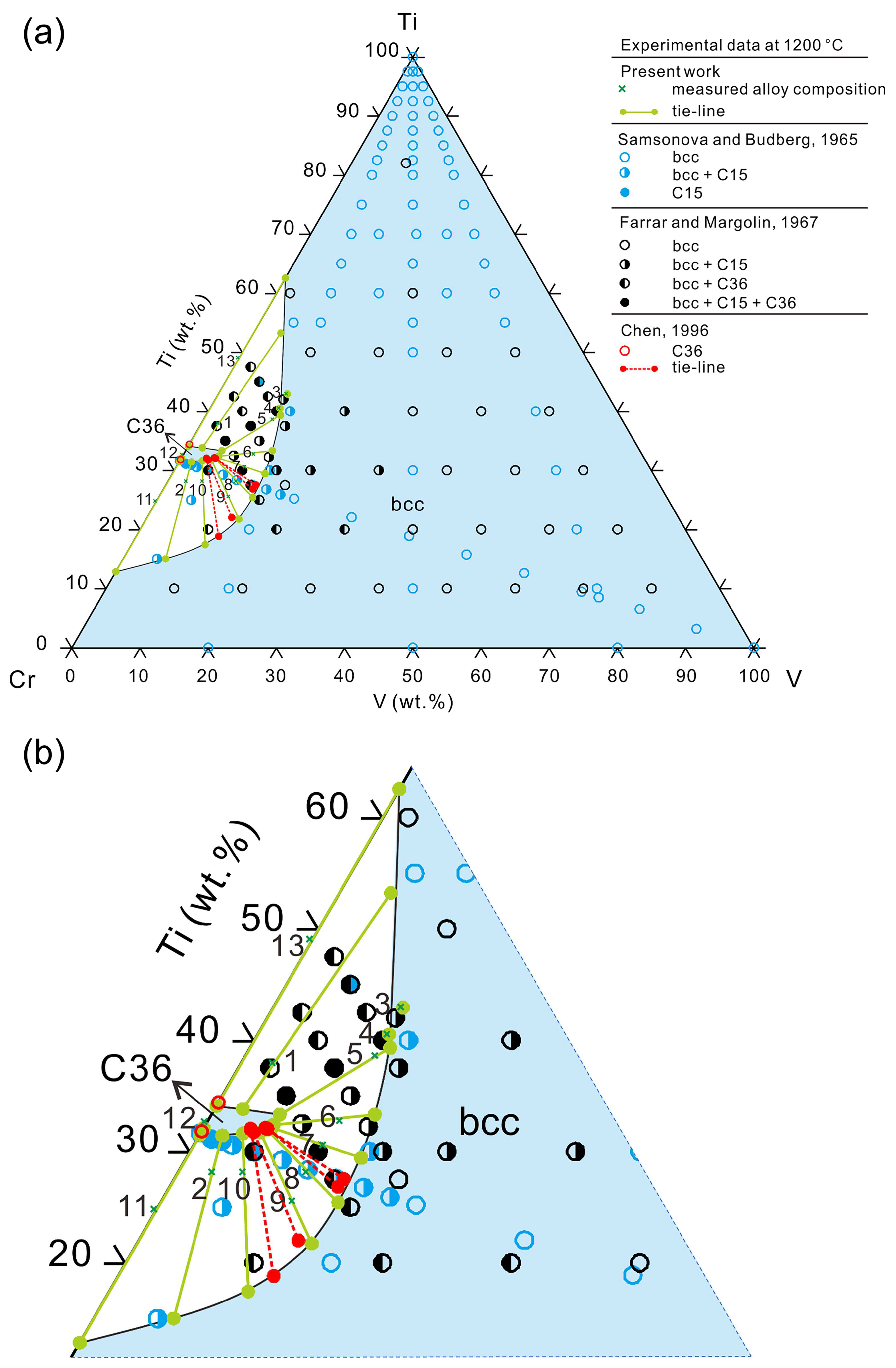
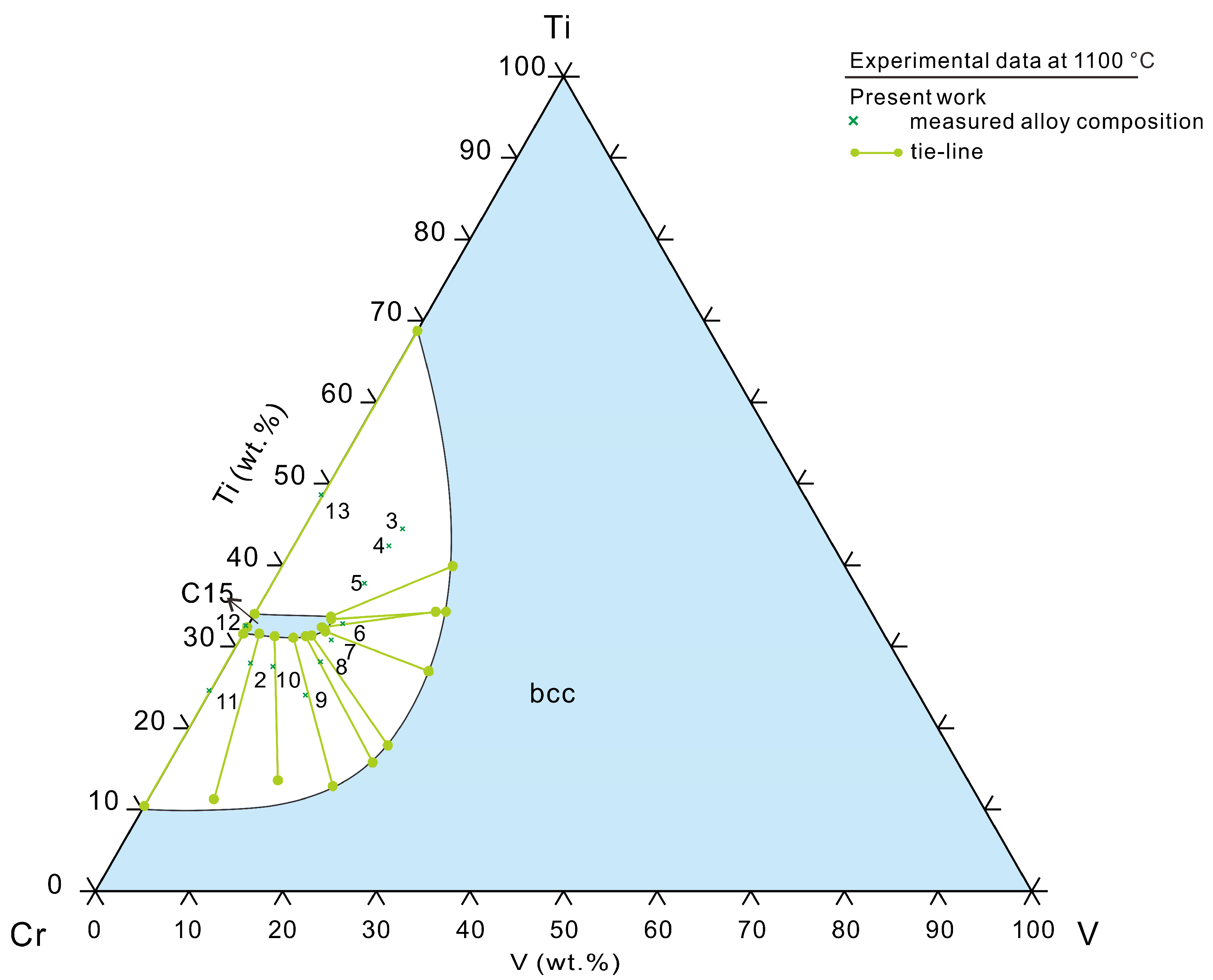
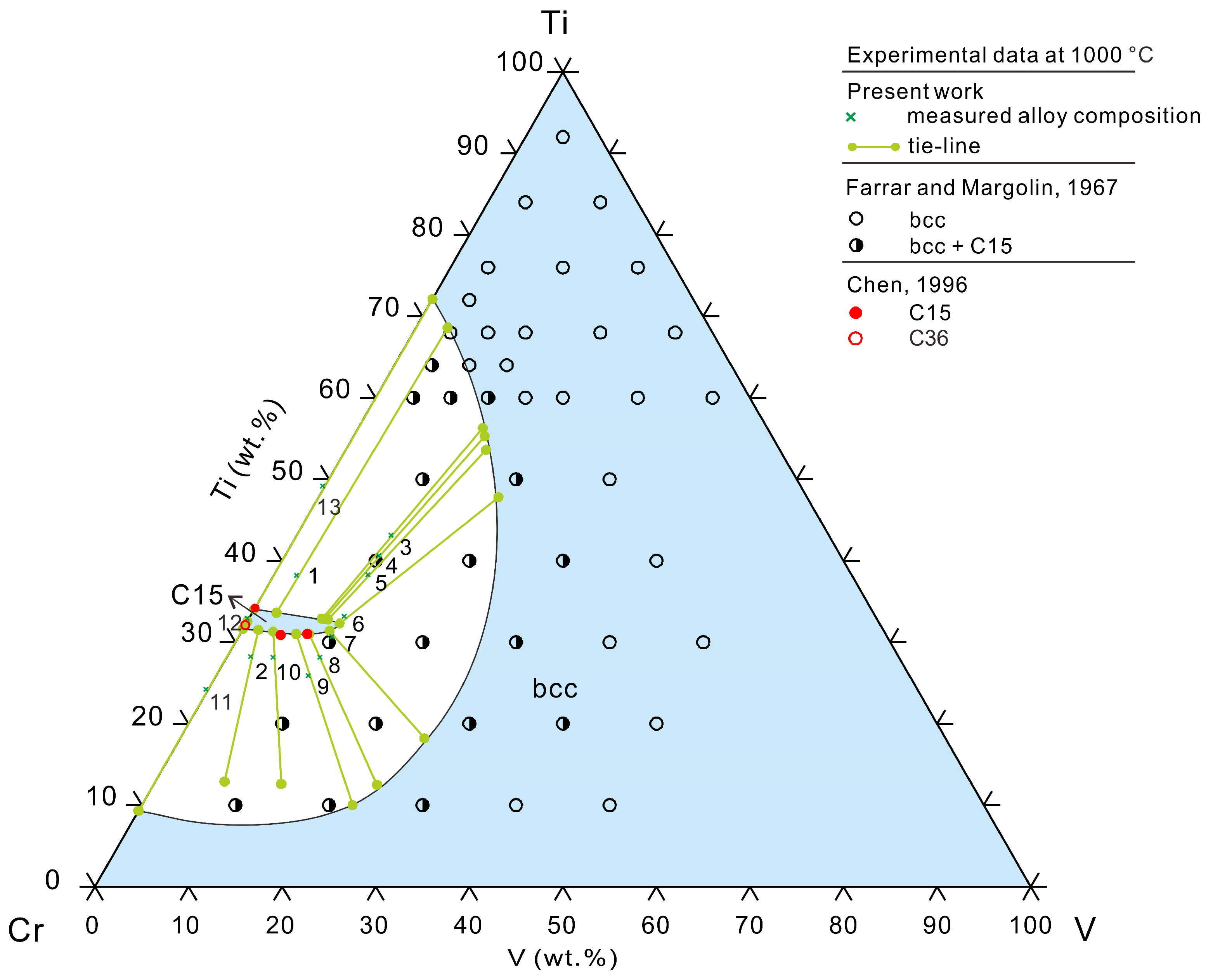


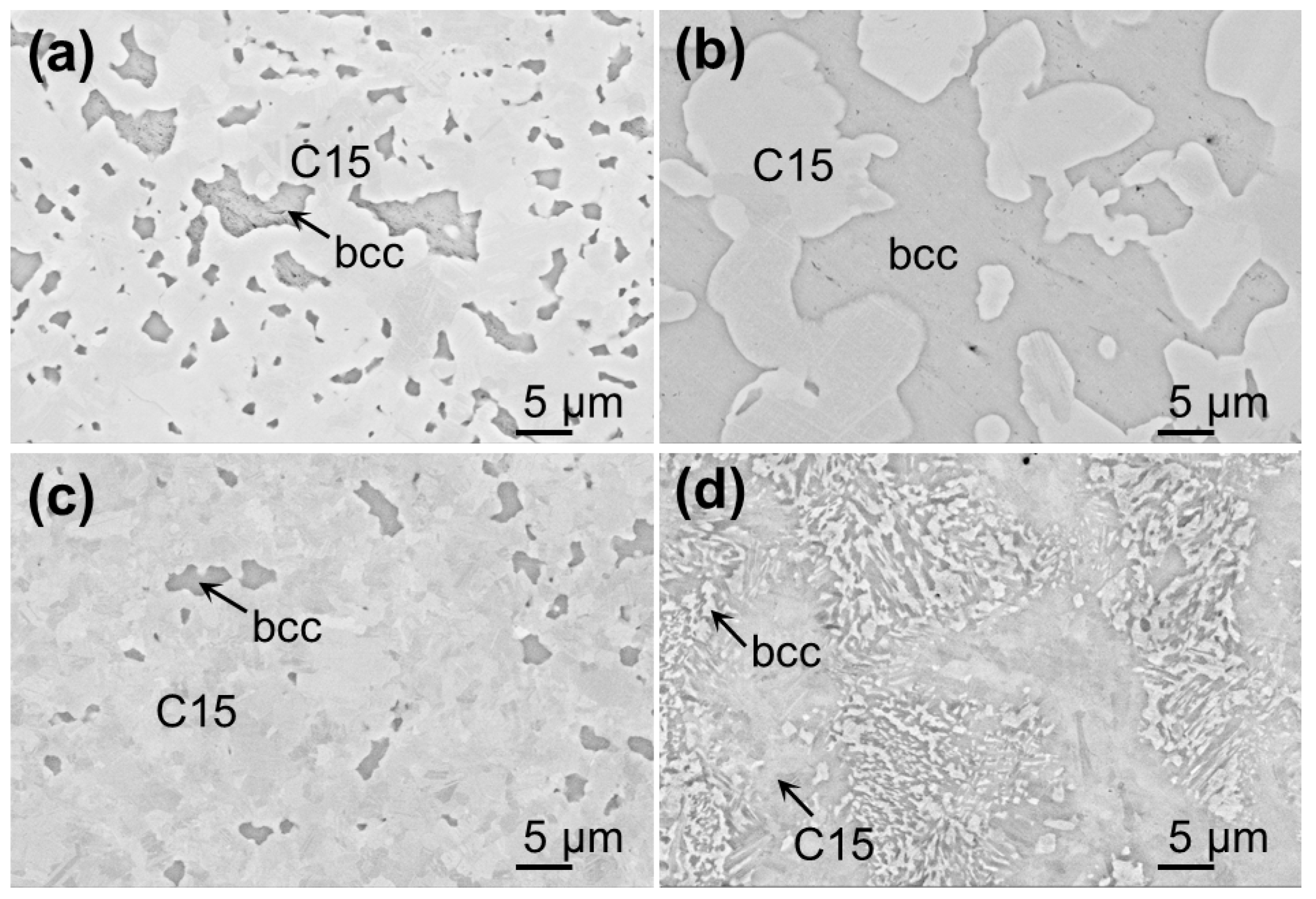
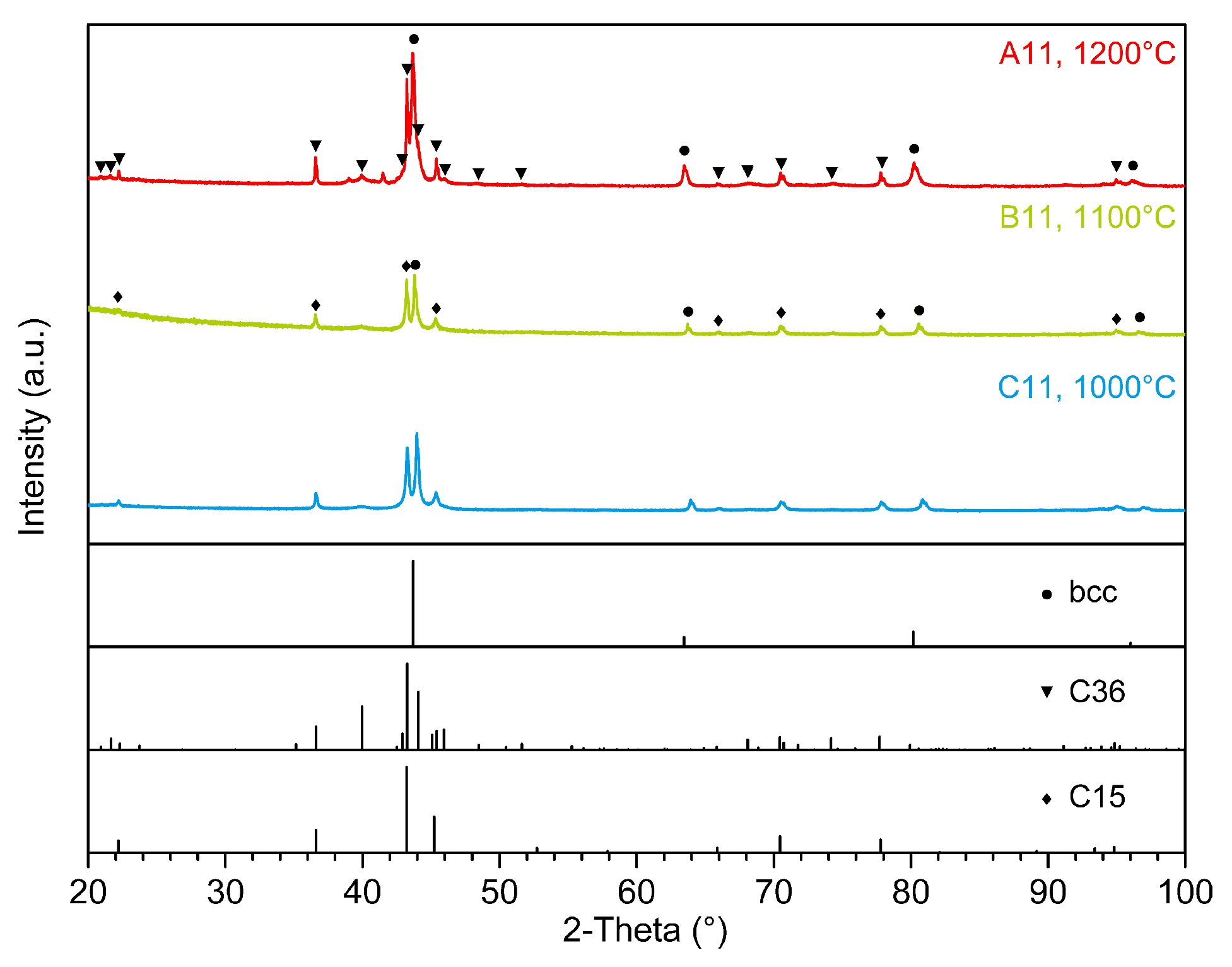
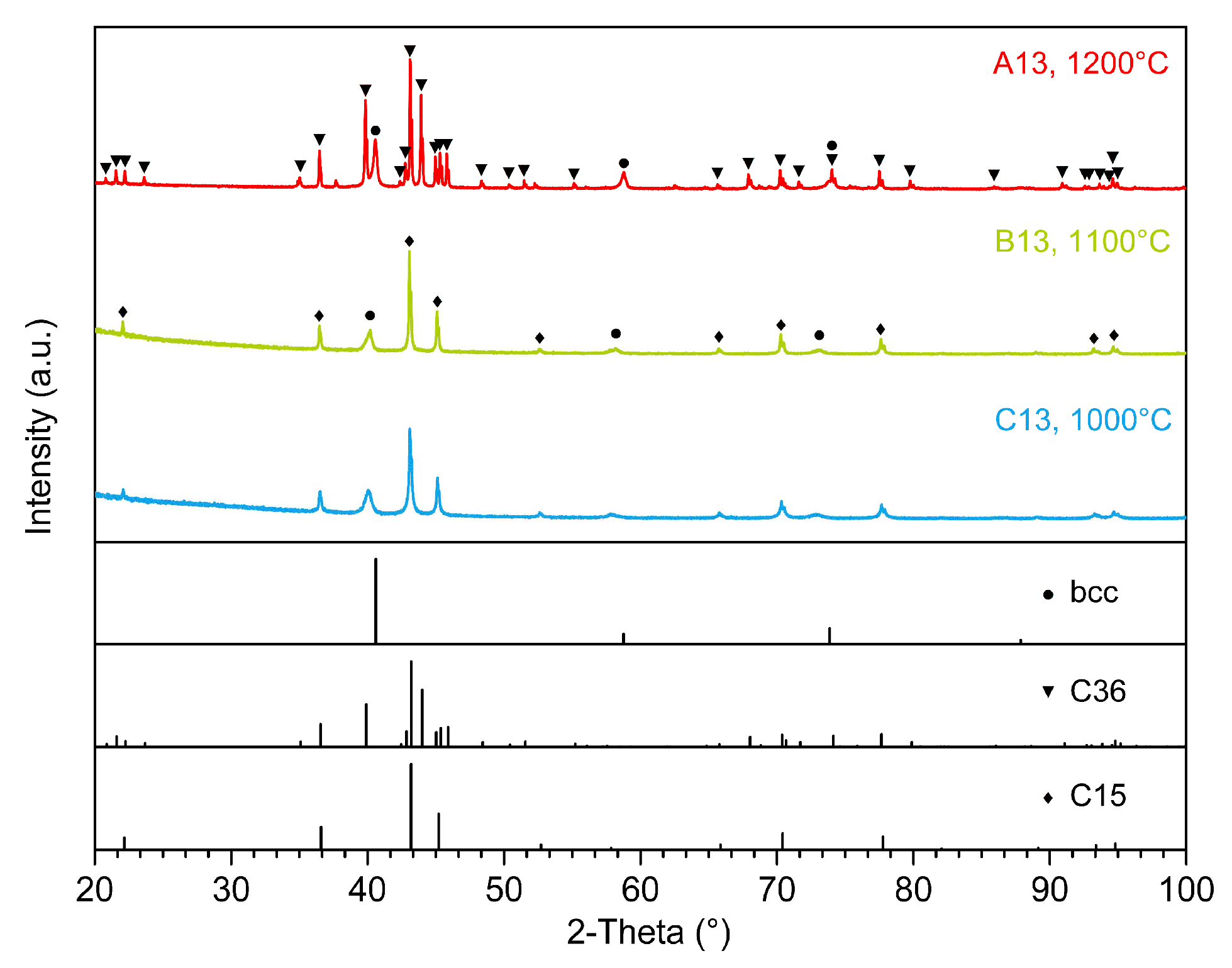


| Phase | Pearson Symbol | Space Group | Prototype |
|---|---|---|---|
| (αTi), hcp_A3 | hP2 | /mmc | Mg |
| (βTi, Cr, V), bcc_A2 | cI2 | m | W |
| α-Cr2Ti, C15 | cF24 | m | Cu2Mg |
| β-Cr2Ti, C36 | hP24 | /mmc | MgNi2 |
| γ-Cr2Ti, C14 | hP12 | /mmc | MgZn2 |
| No. | Alloy Composition, wt.% | ||
|---|---|---|---|
| V | Ti | Cr | |
| 1 | 2.5 | 37.5 | 60.0 |
| 2 | 2.5 | 27.5 | 70.0 |
| 3 | 10.0 | 42.5 | 47.5 |
| 4 | 10.0 | 40.0 | 50.0 |
| 5 | 10.0 | 37.5 | 52.5 |
| 6 | 10.0 | 32.5 | 57.5 |
| 7 | 10.0 | 30.0 | 60.0 |
| 8 | 10.0 | 27.5 | 62.5 |
| 9 | 10.0 | 25.0 | 65.0 |
| 10 | 5.0 | 27.5 | 67.5 |
| 11 | - | 23.5 | 76.5 |
| 12 | - | 32.2 | 67.8 |
| 13 | - | 47.9 | 52.1 |
| No. | Measured Alloy Composition, wt.% | Phase | Measured Phase Composition, wt.% | ||||
|---|---|---|---|---|---|---|---|
| V | Ti | Cr | V | Ti | Cr | ||
| 1200 °C, 120 h | |||||||
| A1 | 2.6 | 38.1 | 59.3 | C36 | 2.2 | 33.9 | 63.9 |
| bcc | 4.0 | 53.3 | 42.7 | ||||
| A2 | 2.8 | 28.3 | 68.9 | C36 | 1.8 | 31.5 | 66.7 |
| bcc | 6.2 | 15.1 | 78.7 | ||||
| A3 | 10.1 | 43.1 | 46.8 | bcc | 10.1 | 43.0 | 47.0 |
| A4 | 10.2 | 40.7 | 49.1 | bcc | 10.2 | 40.6 | 49.2 |
| A5 | 10.3 | 38.7 | 51.0 | C36 | 5.3 | 33.4 | 61.3 |
| bcc | 10.9 | 39.4 | 49.7 | ||||
| A6 | 10.4 | 32.9 | 56.7 | C36 | 5.3 | 32.5 | 62.3 |
| bcc | 12.7 | 33.4 | 54.0 | ||||
| A7 | 10.2 | 30.7 | 59.2 | C36 | 5.3 | 32.2 | 62.4 |
| bcc | 13.6 | 29.5 | 56.9 | ||||
| A8 | 10.1 | 28.3 | 61.7 | C36 | 5.0 | 32.0 | 63.0 |
| bcc | 13.8 | 25.5 | 60.7 | ||||
| A9 | 10.3 | 25.7 | 64.0 | C36 | 4.6 | 31.8 | 63.6 |
| bcc | 13.6 | 21.8 | 64.6 | ||||
| A10 | 5.2 | 28.3 | 66.5 | C36 | 3.3 | 31.7 | 65.0 |
| bcc | 10.8 | 17.5 | 71.7 | ||||
| 1200 °C, 360 h | |||||||
| A11 | - | 24.9 | 75.1 | bcc | - | 12.9 | 87.1 |
| C36 | - | 31.6 | 68.4 | ||||
| A12 | - | 32.8 | 67.2 | C36 | - | 32.2 | 67.8 |
| A13 | - | 49.2 | 50.8 | C36 | - | 34.2 | 65.8 |
| bcc | - | 62.6 | 37.4 | ||||
| 1100 °C, 240 h | |||||||
| B2 | 2.8 | 28.0 | 69.2 | C15 | 1.7 | 31.6 | 66.7 |
| bcc | 7.0 | 11.3 | 81.8 | ||||
| B3 | 10.8 | 44.5 | 44.7 | C15 | 8.3 | 33.7 | 57.9 |
| bcc | 18.2 | 39.9 | 41.9 | ||||
| B4 | 10.4 | 42.4 | 47.3 | C15 | 8.5 | 33.4 | 58.1 |
| bcc | 20.3 | 34.3 | 45.4 | ||||
| B5 | 10.1 | 37.8 | 52.1 | C15 | 8.0 | 32.4 | 59.6 |
| bcc | 19.2 | 34.3 | 46.5 | ||||
| B6 | 10.2 | 32.9 | 56.9 | C15 | 8.6 | 31.9 | 59.5 |
| bcc | 22.1 | 27.0 | 50.9 | ||||
| B7 | 10.0 | 30.9 | 59.1 | C15 | 7.4 | 31.4 | 61.2 |
| bcc | 22.3 | 17.9 | 59.8 | ||||
| B8 | 10.2 | 28.2 | 61.6 | C15 | 6.8 | 31.3 | 61.9 |
| bcc | 21.7 | 15.8 | 62.5 | ||||
| B9 | 10.6 | 24.1 | 65.3 | C15 | 5.6 | 31.1 | 63.3 |
| bcc | 18.9 | 12.9 | 68.2 | ||||
| B10 | 5.4 | 27.6 | 67.1 | C15 | 3.5 | 31.3 | 65.2 |
| bcc | 12.7 | 13.6 | 73.7 | ||||
| 1100 °C, 480 h | |||||||
| B11 | - | 24.7 | 75.3 | bcc | - | 10.5 | 89.5 |
| C15 | - | 31.6 | 68.4 | ||||
| B12 | - | 32.7 | 67.3 | C15 | - | 32.4 | 67.6 |
| B13 | - | 48.7 | 51.3 | C15 | - | 34.0 | 66.0 |
| bcc | - | 68.8 | 31.2 | ||||
| 1000 °C, 360 h | |||||||
| C1 | 2.7 | 38.2 | 59.1 | C15 | 2.6 | 33.6 | 63.9 |
| bcc | 3.4 | 68.6 | 27.9 | ||||
| C2 | 2.7 | 28.3 | 69.0 | C15 | 1.7 | 31.5 | 66.9 |
| bcc | 7.4 | 12.9 | 79.7 | ||||
| C3 | 10.3 | 43.2 | 46.6 | C15 | 7.8 | 32.9 | 59.3 |
| bcc | 13.3 | 56.3 | 30.4 | ||||
| C4 | 10.2 | 40.7 | 49.1 | C15 | 8.1 | 32.9 | 59.0 |
| bcc | 14.0 | 55.3 | 30.7 | ||||
| C5 | 10.3 | 38.3 | 51.4 | C15 | 8.5 | 32.8 | 58.7 |
| bcc | 15.0 | 53.6 | 31.4 | ||||
| C6 | 10.3 | 33.2 | 56.5 | C15 | 10.0 | 32.3 | 57.7 |
| bcc | 19.2 | 47.8 | 33.0 | ||||
| C7 | 10.2 | 30.7 | 59.2 | C15 | 9.4 | 31.4 | 59.3 |
| bcc | 26.1 | 18.2 | 55.7 | ||||
| C8 | 10.2 | 28.2 | 61.6 | C15 | 7.4 | 31.0 | 61.5 |
| bcc | 23.9 | 12.5 | 63.6 | ||||
| C9 | 10.1 | 25.9 | 64.0 | C15 | 6.0 | 31.0 | 63.0 |
| bcc | 22.5 | 10.0 | 67.5 | ||||
| C10 | 5.2 | 28.2 | 66.5 | C15 | 3.4 | 31.3 | 65.4 |
| bcc | 13.6 | 12.6 | 73.9 | ||||
| 1000 °C, 720 h | |||||||
| C11 | - | 24.2 | 75.8 | bcc | - | 9.3 | 90.7 |
| C15 | - | 31.6 | 68.4 | ||||
| C12 | - | 33.0 | 67.0 | C15 | - | 32.6 | 67.4 |
| C13 | - | 49.2 | 50.8 | C15 | - | 34.0 | 66.0 |
| bcc | - | 72.1 | 27.9 | ||||
Disclaimer/Publisher’s Note: The statements, opinions and data contained in all publications are solely those of the individual author(s) and contributor(s) and not of MDPI and/or the editor(s). MDPI and/or the editor(s) disclaim responsibility for any injury to people or property resulting from any ideas, methods, instructions or products referred to in the content. |
© 2024 by the authors. Licensee MDPI, Basel, Switzerland. This article is an open access article distributed under the terms and conditions of the Creative Commons Attribution (CC BY) license (https://creativecommons.org/licenses/by/4.0/).
Share and Cite
Fu, S.; Wang, J.; Lu, X.-G. Experimental Investigation of Phase Equilibria in the Ti-Cr-V System at 1000–1200 °C. Metals 2024, 14, 498. https://doi.org/10.3390/met14050498
Fu S, Wang J, Lu X-G. Experimental Investigation of Phase Equilibria in the Ti-Cr-V System at 1000–1200 °C. Metals. 2024; 14(5):498. https://doi.org/10.3390/met14050498
Chicago/Turabian StyleFu, Shiyu, Jingjing Wang, and Xiao-Gang Lu. 2024. "Experimental Investigation of Phase Equilibria in the Ti-Cr-V System at 1000–1200 °C" Metals 14, no. 5: 498. https://doi.org/10.3390/met14050498
APA StyleFu, S., Wang, J., & Lu, X.-G. (2024). Experimental Investigation of Phase Equilibria in the Ti-Cr-V System at 1000–1200 °C. Metals, 14(5), 498. https://doi.org/10.3390/met14050498






